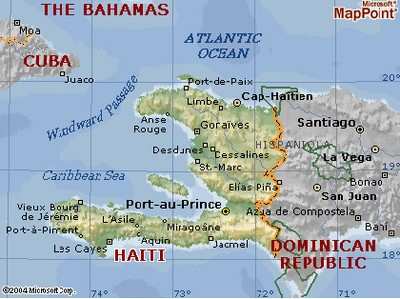All Other Missionary Staff Safe; Non-Essential Personnel
Withdrawing, MAF Sets Up ‘Haiti Disaster and Recover
Fund’
 ANN has learned that one indigenous
MAF (Mission Aviation Fellowship) worker is feared dead and two are
missing following the devastating Jan. 12 earthquake in Haiti, but
none of the ministry’s missionary staff in Haiti were
injured, according to Ron Wismer, crisis team manager at MAF's
headquarters in Idaho. MAF is withdrawing its non-essential staff
and dependents from Haiti, Wismer said. A team of key staff members
will remain to coordinate relief efforts. MAF has sent ministry
directors to Haiti to assess the needs and set up the
ministry’s response.
ANN has learned that one indigenous
MAF (Mission Aviation Fellowship) worker is feared dead and two are
missing following the devastating Jan. 12 earthquake in Haiti, but
none of the ministry’s missionary staff in Haiti were
injured, according to Ron Wismer, crisis team manager at MAF's
headquarters in Idaho. MAF is withdrawing its non-essential staff
and dependents from Haiti, Wismer said. A team of key staff members
will remain to coordinate relief efforts. MAF has sent ministry
directors to Haiti to assess the needs and set up the
ministry’s response.
“We are grateful to God for his protection of our
missionary staff,” said John Boyd, MAF president. “We
do not yet know the exact status of all of our Haitian staff
members, and ask for your prayers for them and for all the people
of Haiti during this time of great sorrow.”
To respond to the disaster, MAF has set up a “Haiti
Disaster and Recovery Fund.” MAF expects to work with other
relief agencies as they begin providing disaster assistance.
Disaster response is an MAF area of expertise. After an initial
needs assessment is completed, Wismer said the ministry will
coordinate logistics and provide air transportation for aid
agencies working within Haiti. In times of disaster, MAF often
takes government and relief officials on flights to survey and
assess damage and develop a response plan.
Casualties of the quake, Haiti’s worst in more than two
centuries, may run into the tens of thousands, relief sources
estimate.

Devastated homes in a Port-au-Prince
neighborhood,
photo by MAF mechanic Todd Edgerton
Wismer said that the MAF hangar and
airplanes were undamaged in the 7.0 quake, which flattened entire
neighborhoods of wealthy and poor alike. But because the
earthquake’s epicenter and heart of the devastation was in
the capital, Port-au-Prince, none of the planes in MAF’s
fleet of three aircraft have been used.
Missionary staff homes sustained only moderate damage. One
home’s security wall collapsed on two sides, Wismer said.
Missionaries, however, have slept on porches and outside their
homes in the past two nights because of ongoing danger of
aftershocks.

Haiti’s communications infrastructure sustained severe
damage. Cellular phone service is sporadic. Some staff
members’ homes are equipped with VSAT internet connections.
“Skype works if you can find somebody with an Internet
connection,” Wismer said.
MAF has served the missionary community and the people of Haiti
since 1986. Currently, seven MAF missionary families, seven
national staff members, and three aircraft serve 16 airstrips from
a base of operations in Port-au-Prince. MAF also has one email hub
in Port-au-Prince, supporting six clients.
To enable the work and maximize the effectiveness of Christian
workers and agencies, MAF provides missionaries, medical staff and
community development workers the means of ministering to the
people of Haiti through light air transportation services,
communications networks and distance education.

Founded in the U.S. in 1945, MAF missionary teams of aviation,
communications, technology and education specialists overcome
barriers in remote areas, transform lives and build God’s
Kingdom by enabling the work of more than 1,000 organizations in
isolated areas of the world. With its fleet of 55 bush aircraft
– including the new KODIAK – MAF serves in 31
countries, with an average of 101 flights daily across Africa,
Asia, Eurasia and Latin America. MAF pilots transport missionaries,
medical personnel, medicines and relief supplies, as well as
conduct thousands of emergency medical evacuations in remote areas.
MAF also provides telecommunications services, such as satellite
Internet access, high-frequency radios, electronic mail and other
wireless systems.
 ANN's Daily Aero-Linx (04.13.24)
ANN's Daily Aero-Linx (04.13.24) ANN's Daily Aero-Term (04.13.24): Beyond Visual Line Of Sight (BVLOS)
ANN's Daily Aero-Term (04.13.24): Beyond Visual Line Of Sight (BVLOS) Airborne 04.09.24: SnF24!, Piper-DeltaHawk!, Fisher Update, Junkers
Airborne 04.09.24: SnF24!, Piper-DeltaHawk!, Fisher Update, Junkers Aero-News: Quote of the Day (04.14.24)
Aero-News: Quote of the Day (04.14.24) ANN's Daily Aero-Term (04.14.24): Maximum Authorized Altitude
ANN's Daily Aero-Term (04.14.24): Maximum Authorized Altitude






